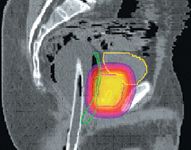Article
High-dose radiation cuts prostate cancer recurrence risk
Boston--Men with localized prostate cancer have a lower risk of biochemical failure after receiving high-dose radiation versus conventional-dose conformal radiation. Moreover, the benefit from the higher-dose treatment, using a modern approach to radiation delivery, comes without an increase in serious urinary or rectal morbidity, according to a new study.

Lead author Anthony L. Zietman, MD, professor of radiation oncology, Massachusetts General Hospital and Harvard Medical School, Boston, said this study demonstrates that the way men used to be treated with external beam radiation was, in retrospect, inadequate and that contemporary high-dose radiation now can eradicate more prostate tumors.
"If you could not deliver the radiation with accuracy, you could only give a certain radiation dose, above which you could end up with lasting and troublesome damage to the rectum and bladder," Dr. Zietman said.

At 5 years, the proportions of men free from an increasing PSA level, or biochemical failure, were 61.2% for conventional-dose and 80.4% for high-dose therapy, a 49% reduction in the risk of failure.
The advantage of high-dose therapy was observed in both the low-risk group, defined as patients with PSAs less than 10.0 ng/mL, Gleason scores of 6 or less, and T-stages of T2a or less, and the higher-risk subgroups. No significant difference in overall survival rates between the treatment groups has been reported. One percent of patients receiving conventional-dose and 2% receiving high-dose radiation experienced acute urinary or rectal problems of Radiation Therapy Oncology Group (RTOG) grade 3 or greater.
Clinical implications
Dr. Zietman said the fact that patients in the conventional treatment group had a greater tendency for biochemical failure could influence survival rates between the groups in the next 10 or more years.
"Prostate cancer grows very slowly and, after treatment, it can come back very slowly. It usually takes 10 or 15 years to feel the benefit from radiation treatment or surgery, so we did not expect any survival difference at this time. These patients will be followed for at least another 10 years. Over that time, we would expect a difference to emerge," he said.
Researchers noted a slightly higher rate of mild rectal morbidity (grade 2 complications) with high-dose radiation, but there were no differences between the groups in the rate of more serious grade 3 and 4 complications.
Dr. Zietman observed that, while it is increasingly common for radiation oncologists to use high-dose radiation in the treatment of localized prostate cancer, there remains an understandable fear.
"They fear that if they push up the radiation doses, they are going to increase the normal tissue complications, and most radiation oncologists feel very nervous about pushing the doses higher because of their historic experiences," he said.
This study, however, should work toward changing that thinking so that more patients' prostate cancer would be eradicated with treatment.
Newsletter
Stay current with the latest urology news and practice-changing insights — sign up now for the essential updates every urologist needs.















